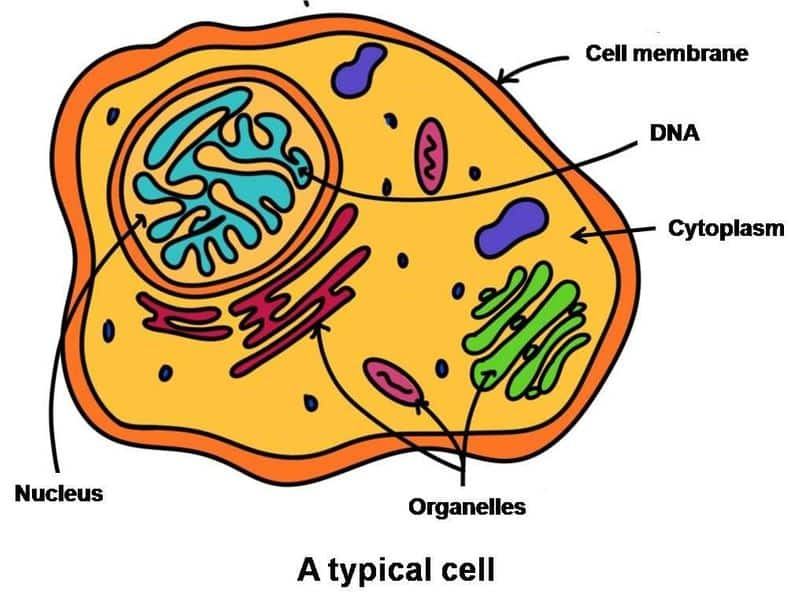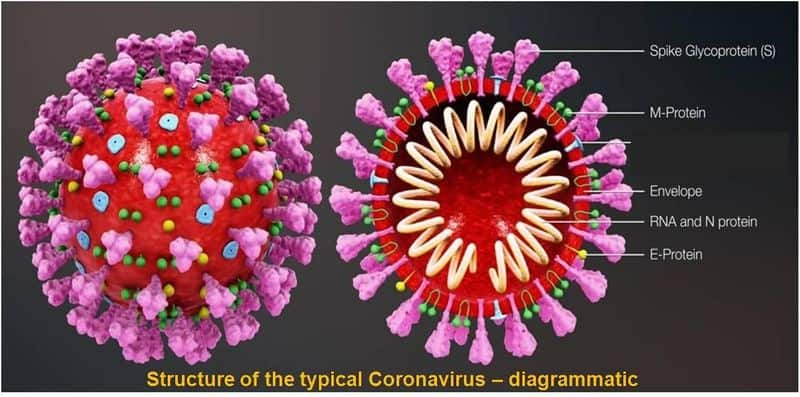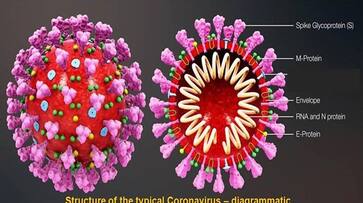Swami Muktidananda, a senior monk and one of the trustees of the Ramakrishna Order writes extensively on the lethality of the dreaded coronavirus, its biology, disease, cure and call for united action
1. What is a virus?
We have to first understand the simple structure of a typical cell very briefly. Then, even as laymen, we will be able to understand how the structure of the coronavirus is different from that of a typical cell. A common man’s understanding and knowledge of the coronavirus holds the key to implementation of preventive measures and solutions to contain the pandemic.
That "protoplasm is the physical basis of life" is a fundamental concept of cell biology and life science defined by William Huxley, an English biologist and anthropologist. The cell content within the cell membrane is called protoplasm. The matrix residing within the cell membrane and outside the centrally located nucleus is called cytoplasm. So, cytoplasm with organelles and nucleus containing the genetic material (DNA) are the constituents of protoplasm.

2. Virus as a bridge between the living and non-living: A virus is an unusual, very primitive parasitic entity that has both living and non-living characteristics. It is a mysterious invisible, non-living, micro-crystal or dust particle when outside a living host. But it assumes life soon after it enters a living host (ranging from amoeba to man and also plants). Therefore, it is an obligatory parasite. It has neither cytoplasm nor cell organelles. It has only genetic material, either DNA or RNA, surrounded by a protein coat. Therefore, the virus is considered as a bridge between the living and the non-living by those who have studied biology and theories of the origin of life.
3. Understanding the nature of the coronavirus: The coronavirus is a virus belonging to the family Coronaviridae. It is opined that the original reservoir of this virus is a non-human host, the horse-shoe bat (in which it causes no harm), from which it jumped to humans. The immune system of the bat is distinct from the human immune system and allows the virus to rapidly multiply within the bat while also protecting it from the harmful effects. Accordingly, bats have been the source of other recent viral disease outbreaks such as SARS, MERS and Ebola This coronavirus emerged in the Chinese city of Wuhan in November 2019 and spread all over the world in a short period. The epidemic is now known as COVID-19 and the virus is known as SARS-CoV-2. The virus is a mutant variety of the SARS (Severe Acute Respiratory Syndrome) coronavirus. This non-living micro dust-like form of the virus is transmitted between people through respiratory droplets when an infected person sneezes or coughs.
4. Structure of the coronavirus: This coronavirus is a spherical, single-stranded RNA (genetic material) virus with a protein coat. It has corona-like extensions called spike proteins on its surface. Hence the name coronavirus. The spike proteins bind to the receptors on the host cell. It is called novel coronavirus (nCoV) because of these spike proteins, which are different from those of other coronaviruses.

5. Fast replication process once it enters the host: In general, the coronavirus multiplies swiftly once it enters the living host. Its RNA replicates after entering the host and produces multiple copies of itself. The RNA particles get themselves covered by protein coats and then come out of the host cells, only to infect new cells. During infection, they enter through the mouth or nostrils through respiratory droplets, make their way into the bronchial tract and lungs gradually, and then they multiply in the alveoli of the lungs. This reduces the expanding and contracting mechanism of the alveoli, leading to fibrosis of the lung. As a result, the function of our oxygen-supplying organ, the lung, gets badly mutilated and respiration gets hindered, making us unable to breathe. This results in a shortage of oxygen supply to the brain and the entire body and the patient dies within a few days.
6. Why is the coronavirus so lethal and fast- spreading? How to break the protein coat of the virus and paralyze its RNA when it is in the non-living form outside the host and in a living form inside the host is a matter of research. Of course, its duration of life outside the host is very limited, to the extent of 3 or 4 days, especially in a tropical hot climate like in India, where the relative humidity is also relatively high. It is believed that a type of WBCs called the natural killer cells (NK cells), which are a component of our innate immunity and which resist any pathogen as the first line of defence, are not very effective against these viruses. People may be carriers of infection of the virus for 1 to 14 days before developing symptoms. The most common symptoms are fever, dry cough, tiredness, and excessive drowsiness. In severe cases, breathing will be difficult. If not contained, it can be fatal, particularly in individuals with co-morbid health conditions like diabetes, high blood pressure, and chronic diseases of heart, lungs, kidneys and liver, and infants aged 12 months and under. Since the coronavirus is spread through respiratory droplets, it is advised not to touch the nose and mouth as these viruses stay on the surface of the hand in a viable state for quite a long time. Also, it is advised to wash the hands thoroughly for at least 20-25 seconds frequently with soap. Sanitizers can also be used to keep the hands clean.
7. Prevention of COVID-19 -- the scientific and social approach: Our body's immune system is yet to develop a new strategy to counter this novel mutant coronavirus. Presently, our WBCs can kill many other invading pathogenic forms like bacteria and others. But we have not yet developed an immune system that can kill the SARS-CoV-2. So, we are neither able to effectively deal with the coronavirus outside the body nor inside. The greater challenge is to find a way for our defence mechanism to deactivate the RNA of coronavirus when it enters the human body or by antibiotics or in developing a vaccine. Since it is fast-spreading through human agency, the epidemic has now become a pandemic, killing human beings fast without yielding to any known medical system. That is the reason thousands have died in such a short time, in China, Italy, Spain and South Korea. As a result of the deeply inter-connected world we now live in involving convenient air travel and cruises, it has spread to nearly 200 countries now. As of 31st March 2020, there were 750,890 confirmed cases and 36,405 deaths. Realizing the magnitude of the epidemic, the Government of India has decided that the only way to contain the epidemic is by making humans not accessible to it by social distancing. People affected by coronavirus have to be isolated in quarantine. Thus, the virus chain has to be broken by not allowing it to enter the human host, so that it perishes after being deprived of a host for a considerable period.
8. Social distancing and “Stay at Home” are the only Mantra: That is why we have messages of preventing the coronavirus infection on the telephone ringtone. We should broadcast it in all media and all possible manners. It is with this intention that the Government of India and all the States have announced a strict lockdown. That is why the COVID-19 preventing "mantras" are "stay at home" and “maintain social distance” everywhere. Even while shopping for essentials, one must maintain a distance of one or two meters from the next person. 'Prevention is better than cure' is the golden proverb we all have heard, but in the context of the coronavirus, prevention is the only cure thus far.
9. The absolute need for a strict, nation-wide lockdown: If we see the extent of devastation caused by the coronavirus in developed countries like Italy, China, Spain, UK, and America, India with its less developed medical infrastructure and habitual group-living in cities and slums, especially in villages, needs to be extra vigilant and cautious in preventing the entry and spread of coronavirus. Our national lockdown may have to be inevitably continued for some more reasonable time and all of us have to educate fellow citizens about the preventive measures more aggressively and convincingly.
10. Therapeutic approaches being tested for potential treatment of COVID-19 in the future: Scientists and physicians all around the world are working together to explore potential treatments for coronavirus. Clinical trials are underway to test a number of candidate treatments that are already approved and safely administered to patients for other diseases. These include the anti-malarial agents’ chloroquine and hydroxychloroquine; HIV treatments lopinavir and ritonavir. An experimental antiviral agent called Remdesivir that was previously developed for treating Ebola is also being explored. Another treatment called convalescent plasma is also under investigation that involves transfusion of critically ill patients with plasma obtained from the blood of patients who have recovered from COVID-19 and built up high levels of antibodies to SARS-CoV-2 to help stimulate a stronger immune response. Several unconventional approaches for rapid vaccine development are being explored that are expected to deliver results in 12-18 months. The first patient was recently dosed in a clinical trial in the USA for a candidate mRNA based vaccine which encodes for a stabilized form of the coronavirus spike protein.
11. Need for a positive attitude at the time of fear and uncertainty: It is very hard to retain positive energy when we are being constantly bombarded with the news of death and economic crisis. However, this time of lockdown is a golden opportunity for reflection, spending quality time with family and exploring hobbies we never had a chance to pursue due to the unending grind of routine life. While social media is a blessing in times of a lockdown to keep in touch with family and friends, it is also a source of rumours and misinformation. We should only rely on government agencies for the most accurate information and guidelines.
12.Need for basic existential solidarity transcending the barriers of caste, creed and religion: It is time that we Indians demonstrate that we are all solidly united, transcending barriers of caste, creed, religious customs and traditions to protect not only our country but the world. Let us pray intensely for the wellbeing of all. Let us invoke the noble and powerful survival instinct and motherly caring instinct hidden in all of us. Let us work together constructively, lovingly, as Indians. This feeling of unity, amity, and love for each other is needed now to keep the COVID-19 pandemic away. This should be our religion, throb of life, the wave of mind, and line of action. So, let us together pray for the protection from this lethal coronavirus and wellbeing of all and take a pledge to stay at home. The famous French surgeon and Nobel laureate, Dr. Alexis Carrel, who was awarded the Nobel Prize in Physiology or Medicine in 1912, has said, "Prayer is the most powerful form of energy one can generate. As a physician, I have seen the patients coming out of melancholy and disease by the serene efforts of prayer."
Our united and the sincere cry of the soul shall be heard by the Almighty, the Omniscient, Spiritual Consciousness, which has created and is sustaining the universe. Let our patriotism, universal brotherhood, and unity find its true expression in this hour of unprecedented crisis. Let the scientific capability of the West and the spiritual capability of the East come together and work reciprocally to fight this terrible pandemic and stave off nemesis. If political and religious leaders, government employees, police, the medical, pharmaceutical and nursing brigades and the business community work with sincerity and honesty as per the scientifically defined line of action, we shall not only conquer the coronavirus pandemic, but also create a new eco-friendly, clean, and spiritually vibrant world of understanding, friendship and love.
More on Swami Muktidananda
He is a post-graduate in science from Institute of Science, Bombay University. He joined the Ramakrishna Order at Sri Ramakrishna Ashrama, Mysore in 1982. He is initiated by Revered Swami Vireswaranandaji Maharaj and had his Sannyasa Diksha from Revered Swami Bhuteshanandaji Maharaj in the year 1993. He served at Sri Ramakrishna Vidyashala, a premier residential Educational Institution of Mysore centre itself for over two decades and as Chief Administrator for 16 years.
He has contributed articles to monthly journals of the Ramakrishna Order like Prabuddha Bharata, Vedanta Kesari and Kannada magazine ‘Viveka Prabha’. He has a special grounding in Education, Indian Philosophy, Yoga Psychology, Indian Culture. He has given a series of talks in ‘Chintana’ Radio Programme Akashavani, Mysore.
He has been also conducting Guided Meditation classes for students and spiritual seekers for years.
Last Updated Apr 14, 2020, 2:16 PM IST









![Salman Khan sets stage on fire for Anant Ambani, Radhika Merchant pre-wedding festivities [WATCH] ATG](https://static-gi.asianetnews.com/images/01hr1hh8y86gvb4kbqgnyhc0w0/whatsapp-image-2024-03-03-at-12-24-37-pm_100x60xt.jpg)
![Pregnant Deepika Padukone dances with Ranveer Singh at Anant Ambani, Radhika Merchant pre-wedding bash [WATCH] ATG](https://static-gi.asianetnews.com/images/01hr1ffyd3nzqzgm6ba0k87vr8/whatsapp-image-2024-03-03-at-11-45-35-am_100x60xt.jpg)


